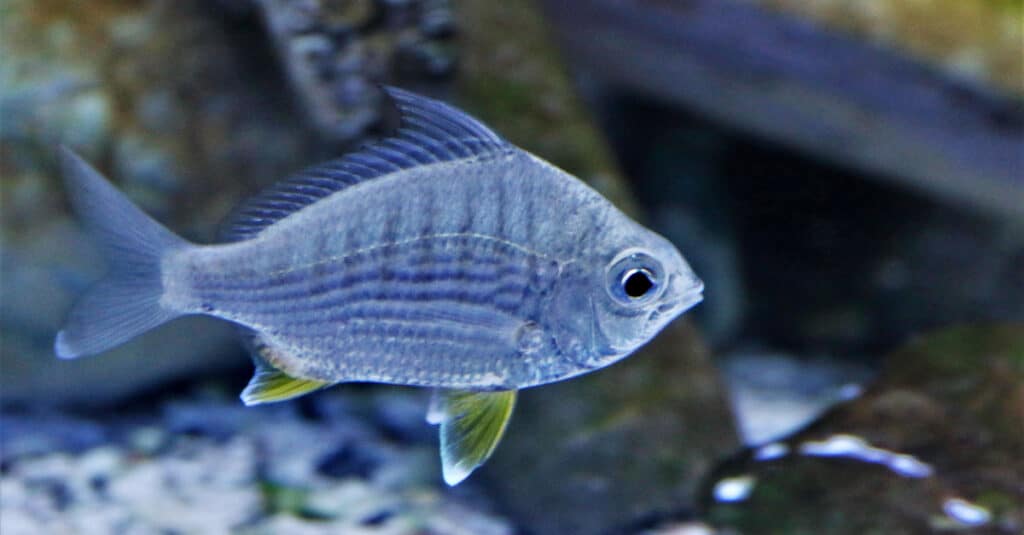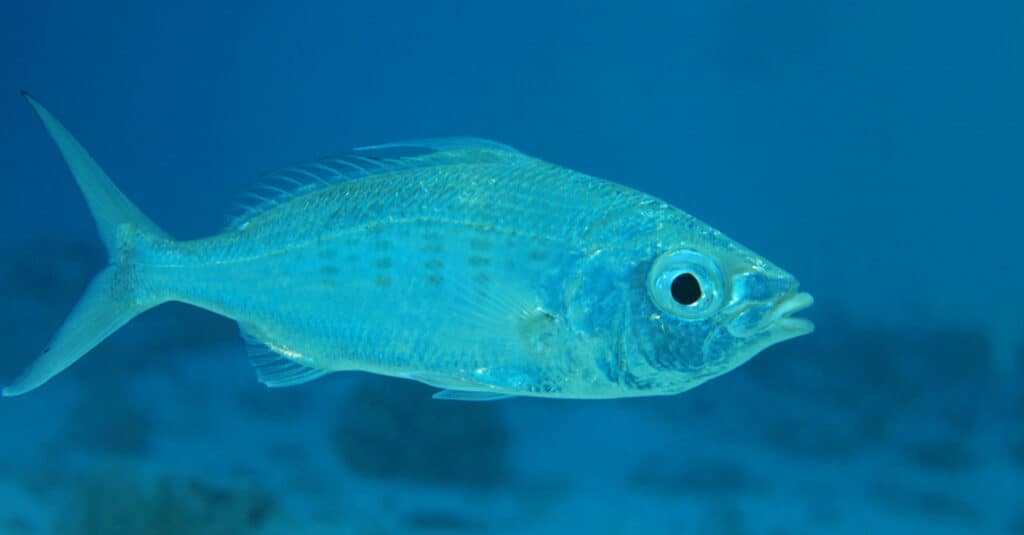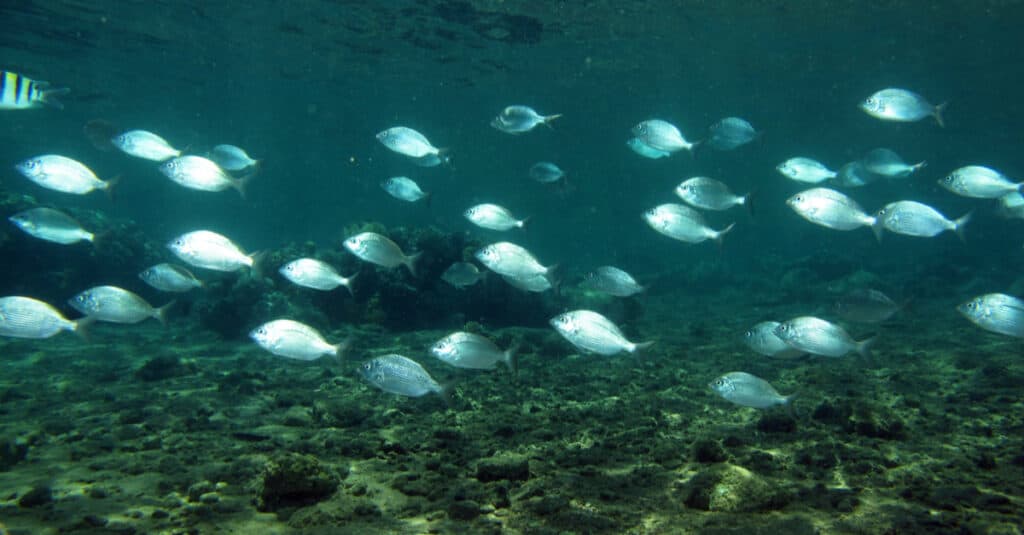Mojarra
The mojarra's protruding mouth allows it to sift along the seabed for food
Advertisement
Mojarra Scientific Classification
Read our Complete Guide to Classification of Animals.
Mojarra Conservation Status
Mojarra Facts
- Prey
- Worms, bivalves, shrimp, and more, in addition to plant matter
- Fun Fact
- The mojarra's protruding mouth allows it to sift along the seabed for food
- Estimated Population Size
- Unknown
- Biggest Threat
- Overfishing
- Most Distinctive Feature
- Shimmering silvery scales
- Other Name(s)
- Silver perch, sand perch, silver biddy, and more
- Gestation Period
- Unknown
- Optimum pH Level
- Varies by species
- Diet
- Omnivore
- Lifestyle
- School
- Type
- Ray-finned fish
- Common Name
- Mojarra
View all of the Mojarra images!
The mojarra fish has brilliant silvery scales that give it a shimmering glow.
The mojarra is a family of marine fish found all over the tropical regions of the globe. More than 40 species, depending on who’s counting, are currently recognized in the family. Some of the most common species include the Irish mojarra, spotfin mojarra, and silver jenny mojarra. High in nutrition, their meat is used in a wide variety of recipes. Many people from all around the world enjoy the taste of their flesh.
4 Mojarra Facts
- The mojarra are known to travel in large schools together for protection.
- Mojarra fish are commonly used as bait. Fishermen will hook them while they’re still alive to attract other kinds of predatory fish.
- These fish may have first evolved more than 55 million years ago during the Eocene period.
- The yellowfin mojarra is known to have a gyroscopic ability. This enables it to remain relatively static when water is flowing quickly around it. Other mojarra may have this ability too, but it hasn’t been studied very well.

Mojarra fish have silvery scales that give the fish a shimmery glow
©Arunee Rodloy/Shutterstock.com
Mojarra: Scientific Name and Genera
The scientific name of the mojarra family is Gerreidae. This may be derived from the Latin word gerres for a kind of fish. They belong to the “perch-like” order of Perciformes.
There are seven genera assigned to the Mojarra (Gerreidae) family. They include:
- Ulaema
- Pentaprio
- Parequula
- Gerres
- Eugerres
- Eucinostomus
- Diapterus
- Deckertichthys
- Gerreidarum
- Aspesiperca
Mojarra is called by the common names goatfish, sand brim, sand perch, silverbelly, and silverbiddy.

Silver biddy fish is one of the many other names by which mojarra are known
©aquapix/Shutterstock.com
Appearance
The mojarra is a fairly small fish, usually measuring no more than 14 inches long (depending on the species), with a heavily forked tail and a series of spines that extends down the back. Their entire body is covered with shimmering silvery scales and sometimes even striped or spotted markings. Mojarra fish have a unique feature called a protractile mouth, which is longer on the bottom than the top. It forms an extended tube when the jaws open up. This helps them to feed at the bottom of the ocean floor. Males tend to be slightly larger than females, but they are otherwise similar to each other. Depending on the species, the body of the mojarra can appear either slender and smooth or a little rougher than usual.

Mojarras have protractile mouths that are longer on the bottom than on the top that make eating off the ocean floor easier
©Peter Leahy/Shutterstock.com
Distribution, Population, and Habitat
Mojarra are found in warm, salty water near the coast and sometimes even inland freshwater as well. They are particularly common near the Atlantic side of Central America and South America, but they’re found all throughout the Pacific Ocean and the Indian Ocean. The population numbers vary by species, but according to the IUCN Red List, most mojarras are considered to be species of least concern. They face few major threats in the wild. They are sometimes heavily fished, however.
Predators and Prey
The mojarra is an omnivorous fish that sifts along the sandy bottom of the shallow sea. Their protractile mouth helps a great deal to scoop up small plants and animals.

Mojarra swim in large schools for protection
©Laura Dts/Shutterstock.com
What eats the mojarra?
The mojarra fish is preyed upon by larger predatory fish such as sharks. The prevalence of hiding spots around the shallow coast provides a degree of protection against potential predators. They also travel together in schools to help them avoid being eaten.
What does the mojarra eat?
The mojarra feeds on plant matter, worms, shrimp, bivalves, and all types of other crustaceans on the seafloor. It spends a great deal of time every day in search of food to consume.
Reproduction and Lifespans
Mojarra gather to spawn in the warm months about once a year. They reproduce by laying their eggs at the bottom of the shallow seafloor. The dense vegetation provides protection for the eggs and later the juveniles until they are ready to fend for themselves. Unfortunately, due to lack of study, there is still a lot about the reproductive behavior of this family of fish that we still don’t understand. Scientists don’t even have a good grasp of the mojarra’s total lifespan, but some of these fish have been known to live for four years or more.

Mojarras have protractile mouths that are longer on the bottom than on the top that make eating off the ocean floor easier
©Peter Leahy/Shutterstock.com
Mojarra in Fishing and Cooking
The mojarra is a popular choice of seafood all over the world. It is said to have a subtle, delicate taste that isn’t too strong or fishy with a high amount of nutrition. They can be grilled, baked, and fried as is desired. The mojarra frita, sometimes flavored with citrus, is a particularly popular recipe. However, you should be aware that the meat may contain high levels of mercury because the toxin can build up in the food chain. The amount of mercury can vary by location, but mojarra may be particularly prone to it because they eat some of the waste dumped near the shore. Consumption should probably be limited no matter which recipes you decide to make. The FDA does not provide a recommendation for the mojarra specifically, but most marine fish should be limited to just 1 to 3 servings per week.
View all 164 animals that start with MMojarra FAQs (Frequently Asked Questions)
Where do mojarra live?
Mojarra live in warm, shallow seas all over the world. They are particularly common on the Atlantic side of the Americas.
Is mojarra safe to eat during pregnancy?
Pregnant women might want to exercise more caution than usually when consuming seafood. It is a good idea to limit or eliminate mojarra completely from your diet.
Is a mojarra a tilapia?
While they might look somewhat similar, the tilapia is actually a type of freshwater cichlid. They belong to the order Cichliformes. This means they’re not that closely related at all. People might accidentally mistake them anyway because they both tend to have shiny shimmering scales and a protruding mouth. Confusingly, the name mojarra is also used in some Latin America countries to refer to the tilapia.
What is mojarra in English?
The mojarra has a few different names in English, including the silver perch and sand perch, but for the most part, many English speakers simply call it the mojarra.
What is the pronunciation for mojarra?
The pronunciation in Spanish would be mo-har-ah. The English pronunciation simply follows the Spanish as well.
Are mojarra fish good to eat?
Yes, the mojarra is considered to be high in good nutrition such as omega-3 fatty acids and relatively low in calories. A serving size of 3 ounces contains about 100 calories and 2 grams of fat. Not everyone may enjoy the taste, but in general it is a popular dish throughout the tropical Americas.
Thank you for reading! Have some feedback for us? Contact the AZ Animals editorial team.
Sources
- Britannica / Accessed April 20, 2022
- All Things Nature / Accessed April 20, 2022
- My Fitness Pal / Accessed April 20, 2022















